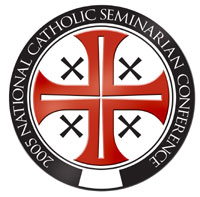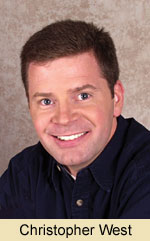National Seminarian Conference
to be held
at Saint Meinrad
By Sean Gallagher
“I know well the plans I have in mind for you, says the Lord, plans for your welfare, not for woe, plans to give you a future full of hope” (Jer 29:11).
This was a message from the Lord that the prophet Jeremiah delivered to the people of Israel in exile in Babylon. He wanted to show them that, despite their difficulties, a bright future lay in store for them.
It is the same message that the seminarians at Saint Meinrad School of Theology have embraced and which they have chosen as the theme for the National Catholic Seminarians Conference being held at the southern Indiana seminary this weekend.
 According to Benedictine Father Mark O’Keefe, president rector of the seminary, the conference was the initiative of the seminarians and serves as a sign of their enthusiasm for the life and ministry as priests that lie before them.
According to Benedictine Father Mark O’Keefe, president rector of the seminary, the conference was the initiative of the seminarians and serves as a sign of their enthusiasm for the life and ministry as priests that lie before them.
“I think it shows a real excitement about their vocation, about the priesthood,” he said. “And I think that they, by wanting to host this conference and all of the work involved in it, have a strong desire to network with other seminarians to demonstrate their pride in the Church and their love for the Church and their love for their vocation.”
More than 100 seminarians from 16 seminaries and more than 40 dioceses plan to attend the conference.
Scheduled speakers for the conference include Bishop Felipe Estevez, an auxiliary bishop of the Archdiocese of Miami, retired Benedictine Archabbot Lambert Reilly, Redemptorist Father Tom Forrest, and author and speaker Christopher West.
Father Mark said that many in the Church today might think that, in light of the priestly sexual abuse scandal of the past few years, the morale of priests and seminarians is low. But he said that the enthusiasm for this conference among the seminarians shows otherwise.
“I think what this conference tells the Catholic laity and the Church at large is that there are men who are mature and healthy and faith-filled who are anxious to embrace a priestly vocation,” he said. “And they understand the challenges of living it and yet they’re filled with hope.”
Rick Nagel, an archdiocesan seminarian in his second year of studies at Saint Meinrad, agreed with Father Mark.
“It’s an indicator of our enthusiasm about the priesthood, about holy orders, about our formation in the seminary,” he said. “There’s a tremendous enthusiasm. Every seminarian here at Saint Meinrad is on a committee and working in some capacity to be able to host this.”
 In his presentation, Christopher West, who teaches at St. John Vianney Theological Seminary in Denver, will reach to the heart of what many consider to be the main challenge to the hopefulness of today’s seminarians: the life of celibacy which they are called to embrace.
In his presentation, Christopher West, who teaches at St. John Vianney Theological Seminary in Denver, will reach to the heart of what many consider to be the main challenge to the hopefulness of today’s seminarians: the life of celibacy which they are called to embrace.
In an interview with The Criterion, West said that a priest’s life of celibacy can be a source of hope for the faithful if they embrace the “sexual redemption” taught by Pope John Paul II in a series of 129 talks given over several years in the early 1980s which, taken together, have become known as the theology of the body.
From this perspective, according to West, sexuality is transformed from a satisfaction of lust to the opportunity to give of oneself in love.
“This is the paradigm for Christian sexuality—self-donation,” he said. “Not lust, but a redeemed understanding of sexuality and a redeemed experience of sexuality that enables us to become a true gift for others.
“Only to the degree that we experience this liberation from lust does the celibate vocation become a real possibility. Otherwise, it is a life of hopeless repression.”
In fact, West argued that this unredeemed repression might be one explanation for the priestly sexual abuse revealed over the past few years.
“When we repress sexuality rather, than experience the redemption of sexuality,” he said, “its only a matter of time before we indulge and indulge in grossly distorted way because repression inevitably leads to gross indulgence. I think that this is one way of understanding what has … [been] unearthed over the last several years.”
Nagel said that the message offered by West and the other speakers is good news for all the faithful, not just for seminarians like himself.
“The faithful need good news too,” he said. “They need hope like we need hope. Sometimes when there are dark clouds over the Church, we all do need to rise up and share what we know to be true.”
A “critical” truth that West hopes that the seminarians who are tomorrow’s priests will share with those to whom they will minister is that there is a paradoxical “complementarity” between the vocations to the priesthood and to marriage.
Pointing to what St. Paul wrote in the fifth chapter of his Letter to the Ephesians, West said that the sacrament of marriage is a sign of the heavenly marriage of Christ to the Church. The celibate life of a priest points married couples to the fulfillment in heaven of the sacramental life they live here on earth.
“The ultimate destiny of every human being and the ultimate satisfaction of our desires for love and union is not the marriage of man and woman here on earth,” he said. “That’s only a foreshadowing, only a glimmer of the marriage of Christ and the Church that awaits us in eternity.
“Christ called some to be celibate for the sake of the Kingdom—not because marriage is bad, not because sex is dirty—but for the sake of the Kingdom. The Kingdom must be understood in this context as this eternal marriage, the eternal union of Christ and the Church.”
The hope that West wants to provide the seminarians in his presentation is just one of a number of ways that the conference’s speakers will try to show the bright future for the priesthood and the Church.
“It’s very broad-based, which shows their sense of the facets that priestly life and ministry is going to have to embrace,” Father Mark said. “The seminarians have taken a very broad approach. I think it’s a sign to the laity that these men are thinking about their vocations. They’re excited about their ministry and they understand its complexity.” †
 According to Benedictine Father Mark O’Keefe, president rector of the seminary, the conference was the initiative of the seminarians and serves as a sign of their enthusiasm for the life and ministry as priests that lie before them.
According to Benedictine Father Mark O’Keefe, president rector of the seminary, the conference was the initiative of the seminarians and serves as a sign of their enthusiasm for the life and ministry as priests that lie before them.  In his presentation, Christopher West, who teaches at St. John Vianney Theological Seminary in Denver, will reach to the heart of what many consider to be the main challenge to the hopefulness of today’s seminarians: the life of celibacy which they are called to embrace.
In his presentation, Christopher West, who teaches at St. John Vianney Theological Seminary in Denver, will reach to the heart of what many consider to be the main challenge to the hopefulness of today’s seminarians: the life of celibacy which they are called to embrace.